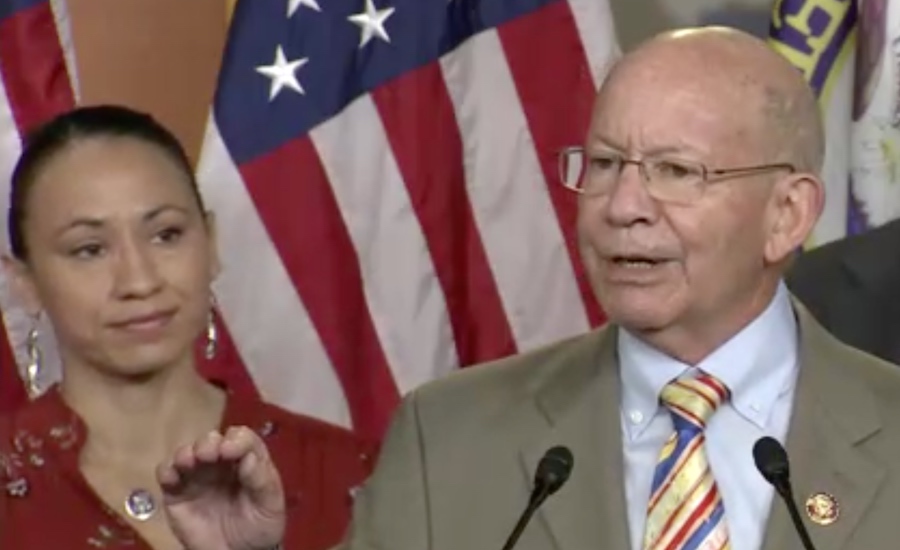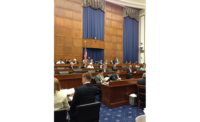Another building block for infrastructure legislation has moved into place with the House’s approval of a five-year $715-billion surface transportation and water infrastructure package.
The INVEST in America bill, basically written by Democrats, passed the House on July 1 on a 221-201 vote, almost completely along party lines. Just two Republicans voted for the bill, Reps. Brian Fitzpatrick (Pa.) and Christopher Smith (N.J.); no Democrats voted against it.
Public transit wold receive $109 billion and passenger and freight rail would get $95 billion, including $32 billion for Amtrak.
Speaker Nancy Pelosi (D-Calif.) said in a June 30 press briefing that the INVEST bill is “a strong jobs-creating package that seizes the once-in-a-century opportunity to rebuild America’s infrastructure.”
[View summary of the INVEST in America Act here.]
Of the bill’s total authorizations, funds for highway and bridge construction and highway safety programs represent the largest component, with $343 billion.
Public transit would receive $109 billion and passenger and freight rail would get $95 billion, including $32 billion for Amtrak.
Jim Tymon, American Association of State Highway and Transportation Officials' executive director, said in a statement that the INVEST legislation “is a major step toward reauthorization of the federal surface transportation program.”
In the water infrastructure part of the bill, drinking water infrastructure would receive about $105 billion, including $53 billion for the drinking water state revolving fund (SRF).
Wastewater infrastructure would receive $51.3 billion, including $40 billion for the Clean Water SRF.
Much of the funding, however, would be subject to annual appropriations.
The National Association of Clean Water Agencies noted that the legislation would include the first reauthorization of the Clean Water SRF, and also praised lawmakers for including a permanent program to provide low-income water customers with financial help.
Senate Progress, Too
The Senate also has made progress on infrastructure legislation, but those bills’ funding levels are generally lower than the INVEST bill's.
For example, On April 29, the Senate approved a bipartisan water infrastructure bill totaling $35 billion. Of that amount, $14.7 billion would go for each of the two water SRF programs.
On the transportation front, the Senate Environment and Public Works Committee on May 26 approved a five-year, $312.4-billion highway authorization bill. The Commerce Committee on June 16 cleared a measure that provides $36 billion for rail and $13 billion for highway safety.
A key unknown is how the INVEST in America Act and the Senate bills might mesh with the wider-ranging infrastructure framework that President Joe Biden and a group of Senators agreed to last week.
The $64,000 Question
Jimmy Christianson, Associated General Contractors of America vice president for government relations, said in an interview, “I think that’s the $64,000 question.” He adds, “No one really knows the answer at this point."
The INVEST bill’s main author, Transportation and Infrastructure Committee Chairman Peter DeFazio (D-Ore.), said at the briefing that the bipartisan framework “is an outline and it has good numbers.”
The exception, DeFazio says, is the framework’s $66 billion for rail. “But they’re within shouting distance” of the INVEST Act’s $95 billion in rail funding, he adds.
DeFazio also notes that the bipartisan framework has no policy provisions and the INVEST Act has many such sections. ”You have to have policy (provisions) to do a bill,” he says.
DeFazio adds, "I'm suggesting that substantial amounts of the policy in our bill should be negotiated by the White House and the Senate and the House, to be part of that bipartisan proposal."
AGC's Christianson says that all of these recent public-works measures have “fantastic levels of funding for infrastructure.” But he notes that the bills differ in their policy provisions. “And that's where the rubber ... will hit the road in any negotiations.” That would include negotiations between the House and Senate or on a broader measure that the bipartisan Senate group is developing, Christianson says.






Post a comment to this article
Report Abusive Comment